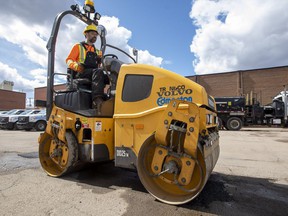Article content
City crews have been hitting the asphalt this spring to repair potholes after a winter that was rough on the roads.
Article content
Workers have so far filled 63,753 potholes, the city announced Thursday. In the city’s last update March 15, around 12,000 potholes had been repaired, meaning crews filled more than 50,000 since then — in just over a month’s time.
Spring is an especially busy season for maintenance teams, a city spokeswoman said.
-
Pothole complaints up, 12,000 filled so far in Edmonton this year
-
Potential tax hike, major boost needed for Edmonton’s snow removal budget: staff
“Edmontonians value access to their city, and a robust roadway maintenance program plays an important part in meeting that they need,” Caitlin Zerebeski, acting director of infrastructure maintenance, said in a news release. “Our dedicated pothole repair crews are hard at work year-round to help keep Edmonton’s roads safe, reliable and accessible for everyone.”
Article content
Road repairs were delayed this year compared to 2021. Last month, Zerebeski said there was more snow and ice this past winter which — along with repeating cycles of freezing, thawing, and freezing again — not only caused delays but damage to roadways.

Potholes form when water melts into the asphalt, which then freezes overnight and expands. It creates a cavity below the surface that can be cracked open when a vehicle drives over it.
“While we face potholes all year, spring melt makes water and moisture more available during the periods of the many freeze-thaw cycles,” she said in March.
Staff monitor complaints to 311 to know where to find roads needing some work, but the city says it also does proactive inspections to identify priority areas based on severity, location and traffic volumes.
For instance, potholes on major roads with higher speeds, bigger and deeper holes, and holes in wheel paths are filled first, the city says. The goal is to inspect high-priority spots within 24 hours and fix them within two days. Holes in alleyways can take up to one year to repair, and lower-priority holes can take up to one month.

